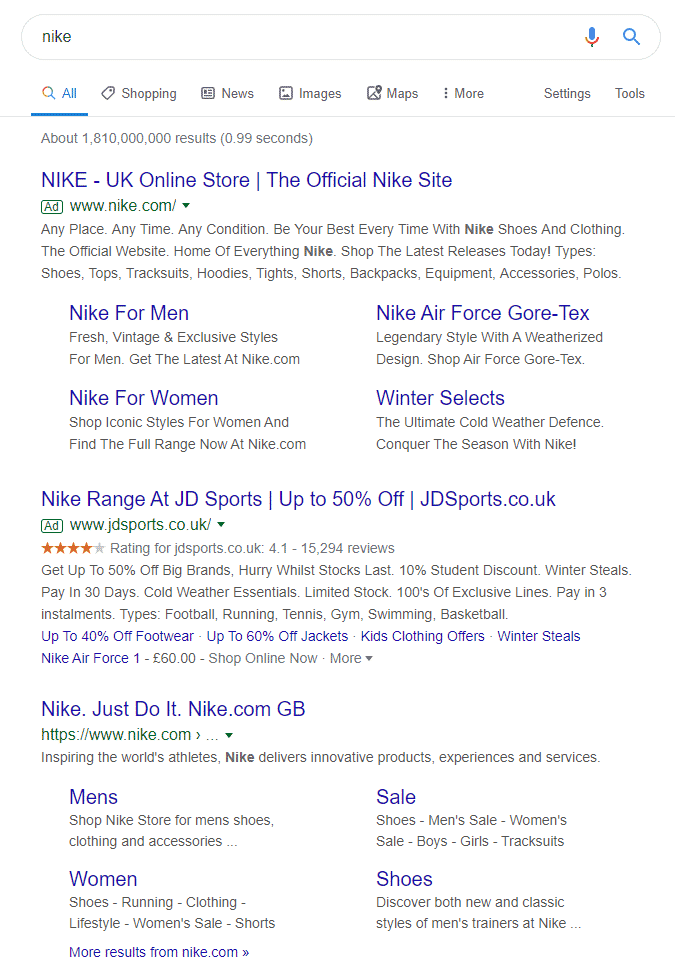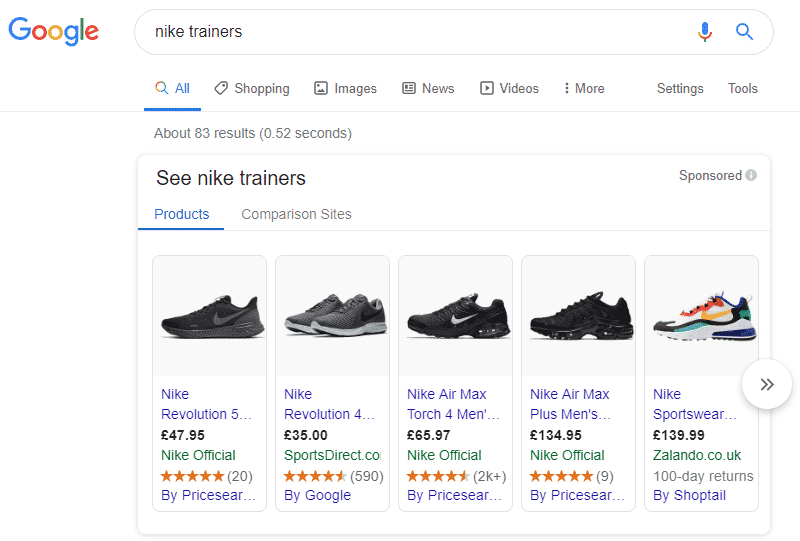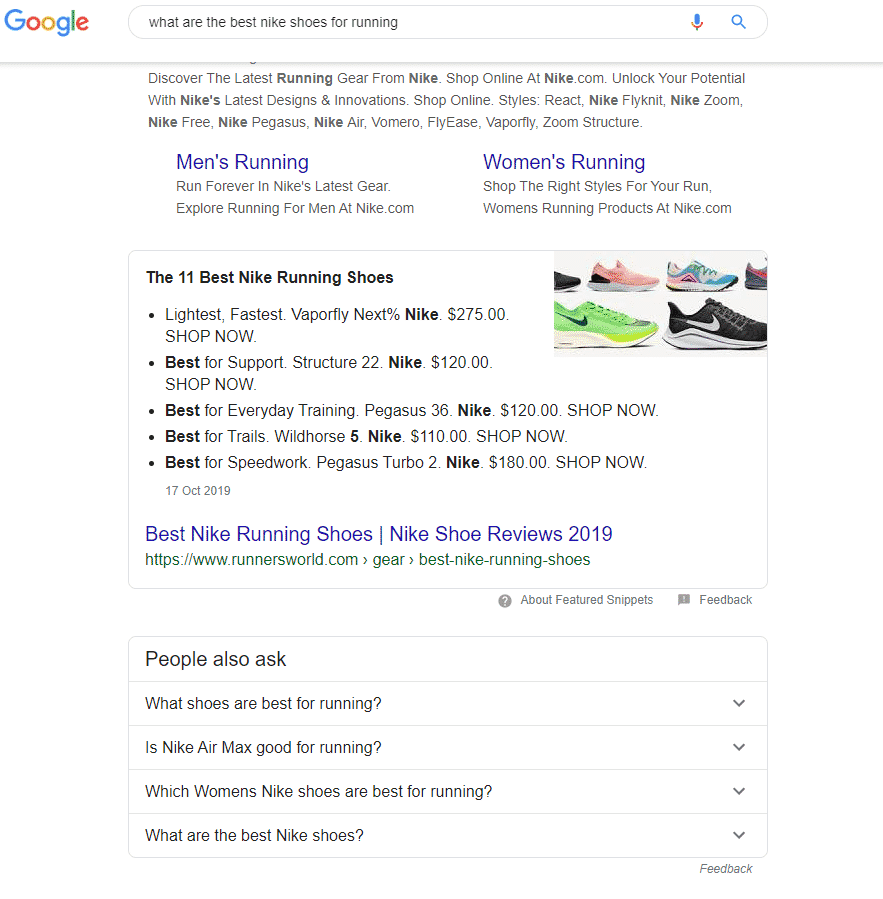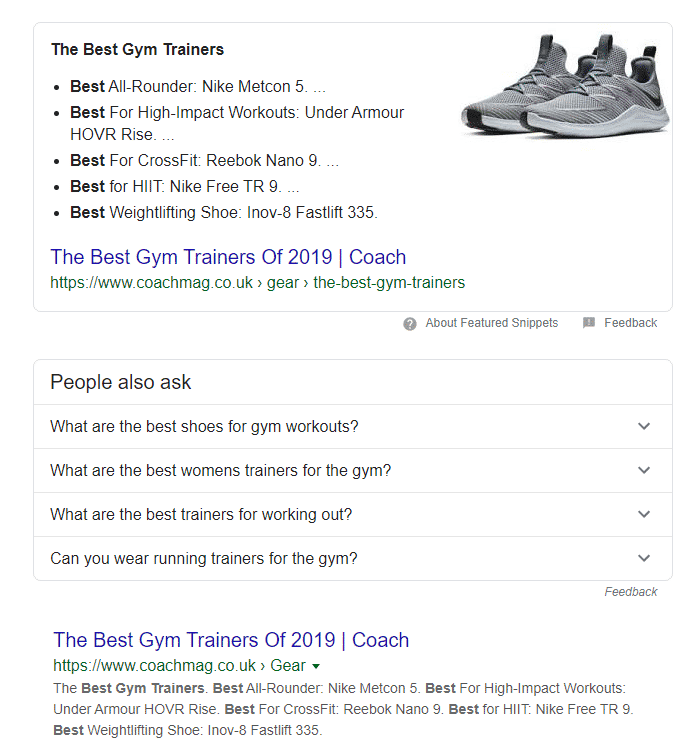In the latest Quibble blog, we’re going to be focusing on the four different kinds of search intent and why they’re important.
We’ll also show you how to optimise your content to improve rankings, increase your click-through-rates and maximise visitor engagement on your website.
What is Search Intent?
Search intent is the motivation behind someone’s search. It is the “why” behind what they type into a search engine.
For instance, when you type ‘Nike’ into Google, your intention may be to find your nearest sportswear shop; whereas someone else may be looking for the Nike Twitter account. It’s these nuances, that, as online business owners, we need to understand in far greater detail to grow online in 2020.
We can break down search intent into four sub-categories:
- Navigational
- Informational
- Transactional
- Commercial
Before we go any further, you’re probably thinking, “but my website is already optimised, and I’m creating content that is reaching my audience. Why do I need to work even harder?”
Well, the honest answer is that optimising your website for specific keywords and creating relevant content is not enough on its own, you need to offer further context. If you can tap into the psychology of why someone is looking for something specific, you’ll have a far better chance of attracting interested searchers to a landing page or blog on your website.
Why is Search Intent Important?
Understanding the different kinds of search intent will give you a good insight into the sort of content that you need to start creating for your audience, based on the psychology behind their search. Not only does this make it easier to create content plans, but you’ll also be able to understand how they can serve your customer’s needs.
When you begin to amplify your content in this way, your site has a much better shot at ranking higher in the SERP’s because you’ve made an effort to tactically put yourself in front of the right customer with the right information.
Because you’re able to understand the nuances of what a searcher is looking for, your content will start to rank for more specific keywords and phrases, which brings higher levels of targeted traffic (and therefore more opportunities for conversion) simply because you’ve tailored content to a particular requirement.
As you start to undertake more research into search intent, you can begin to compose a clear picture of what exactly your customer is searching for and how your product or service can fulfil this need. You can do this by essentially producing in-depth customer personas, which can give you an idea of the different kinds of people that might be interested in your business and the range of search queries they might be using to find you.
Optimising Your Content for Search Intent
Navigational Search Intent
Navigational searches are performed when a user is already aware of the company they’re looking for – so a branded search in other words.
So, to take the example of Nike from earlier, in a navigational search, instead of typing ‘sportswear brand’ someone might simply type ‘Nike’.

As a result of such a broad search, Google priorities the main website.
If a searcher has this intention, it’s safe to assume that they are already well acquainted with your business. In order to cater for these kinds of searchers, you should create landing pages with clear information about your products and services and optimise your homepage with details of your company, what you do and whom you offer your services to.
Include your brand and product or service in the page title, subheadings and metadata, as these are the things that Google will look at when determining whether the website is appropriate to the search.
Informational Search Intent
These kinds of queries are used when someone is looking for information or a solution to a problem.
An informational search is most likely to be in the form of a question, such as a ‘How’, ‘Why’ or ‘What’, where the user is looking for the answer to a question or a guide on how to do something.
Optimising for informational searches means that you’ll also need to add ‘intent modifiers’ to your keywords.
Intent modifiers are added words that steer the intent of the query. So, for example, a searcher might type, ‘Nike trainers’ and find a selection of Nike trainers for sale:

But, if they instead type ‘what are the best Nike trainers for running?’, then Google will know that the searcher is looking for an answer to a more targeted query:

To optimise your page for informational intent, take the question your audience asks and place it into strategic places such as blog titles, URLs and metadata.
Be sure to clearly answer the question in the content, and there’s a good chance your content could even feature in Google’s featured snippets.
Intent modifiers could count as anything we’ve included below:

Content formats closely associated with informational intent are blogs, how-to guides, list posts and step-by-step tutorials.
Transactional Search Intent
Transactional searches are sometimes known as “doing queries” because the searcher is actively looking complete an action, such as buying a product, for example.
Searchers may sometimes use modifiers, but more often than not they’ll just type in the exact product name they’re looking to buy:

The example above shows a search that is actively looking to view a specific product, so Google knows that the searcher wants to be directed to a product page to potentially complete a purchase.
In this case, you’ll want to compose your page design and content to keep the potential buyer focused on the desired outcome, i.e. buying the trainers.
In some cases, the searcher may be looking for information about the product, which is why it’s important to keep the design as simple and straight forward as you can. They’re looking for easy to digest content, good looking images and an easy way to complete their purchase.
For conversion purposes, use lists and bullet-pointed content (that can be scanned quickly) and a prominent call-to-action.
To optimise your product page, you’ll want to use transactional words such as the product name and the brand, and combine it with intent modifiers, such as ‘buy’, ‘discount’, ‘price’, ‘deal’ and ‘cost’ etc.
Transactional queries are focused around service landing pages or easy-to-navigate product pages.
Commercial Intent
In this kind of search, the user knows what kind of product they want, but they haven’t yet decided on a brand. This means they’ve not yet moved into the transactional phase, but they are looking to compare between brands and their products to see if anything closely matches their needs.
For example:

In the case above, the search for “best trainers for the gym”, which is a sign that the searcher isn’t loyal to any brand at this point and is looking to be persuaded.
Other examples of commercial search intent could also include looking for reviews, which, in this case, could be someone looking to compare a couple of different products to see which best fits the searchers active lifestyle.
To rank for these search queries, ensure that you include in-depth product specifications and service descriptions.
You could also create content comparing your product to another similar one on the market and explain within it how and why it’s the best option. This is also a valuable tactic in that even if the customer decides to postpone their purchase; they’re more likely to return to you because you’ve offered them actionable and useful advice.
Conclusion
Creating optimised content for these four kinds of searcher intent will help to improve the visibility of your website by making your content far more relevant to each type of search query.
Content that has specifically been optimised to provide the answer to certain kind of search intent increases click-through-rates since your metadata has already gone some way to telling the user that you are the answer to their question.
Having highly relevant content on your website will mean that engagement with each page increases, by decreasing bounce rates and improving the overall experience of the user.
If you’d like to discuss anything that we’ve mentioned in this blog, or you’re interesting in chatting to us about any of our services, then why not contact us today?

